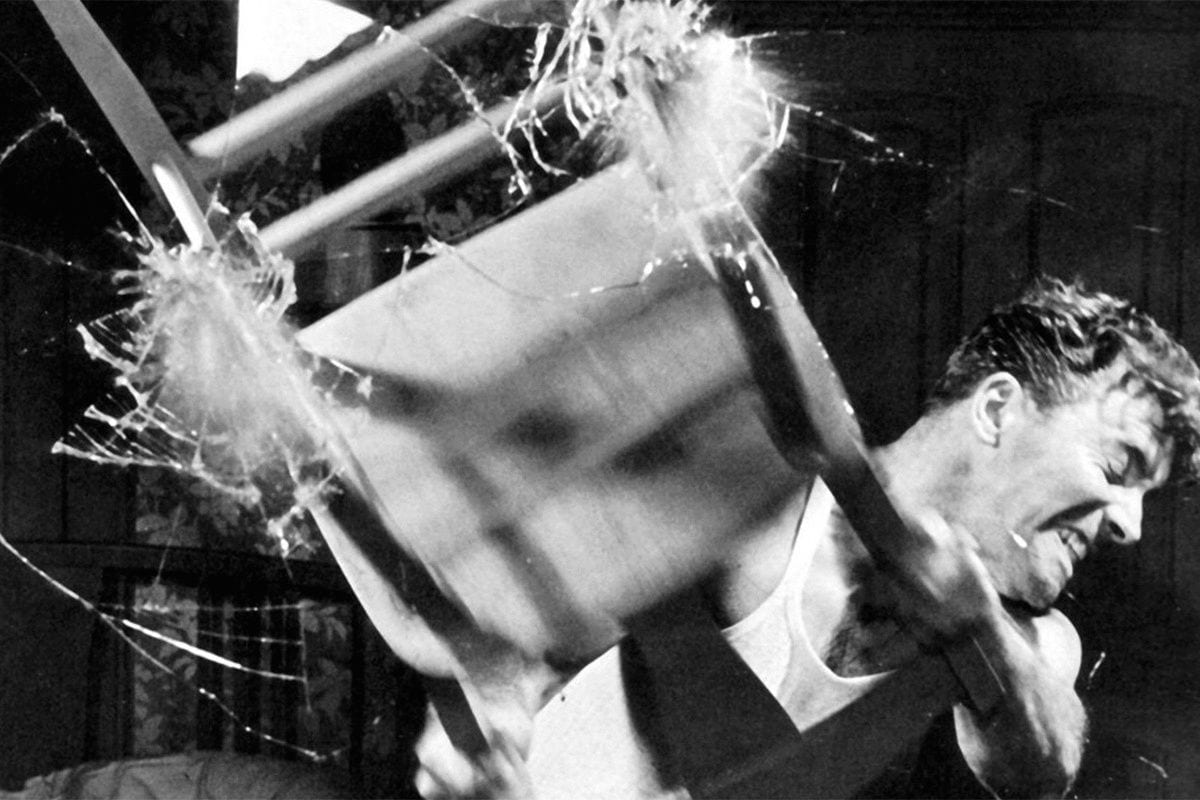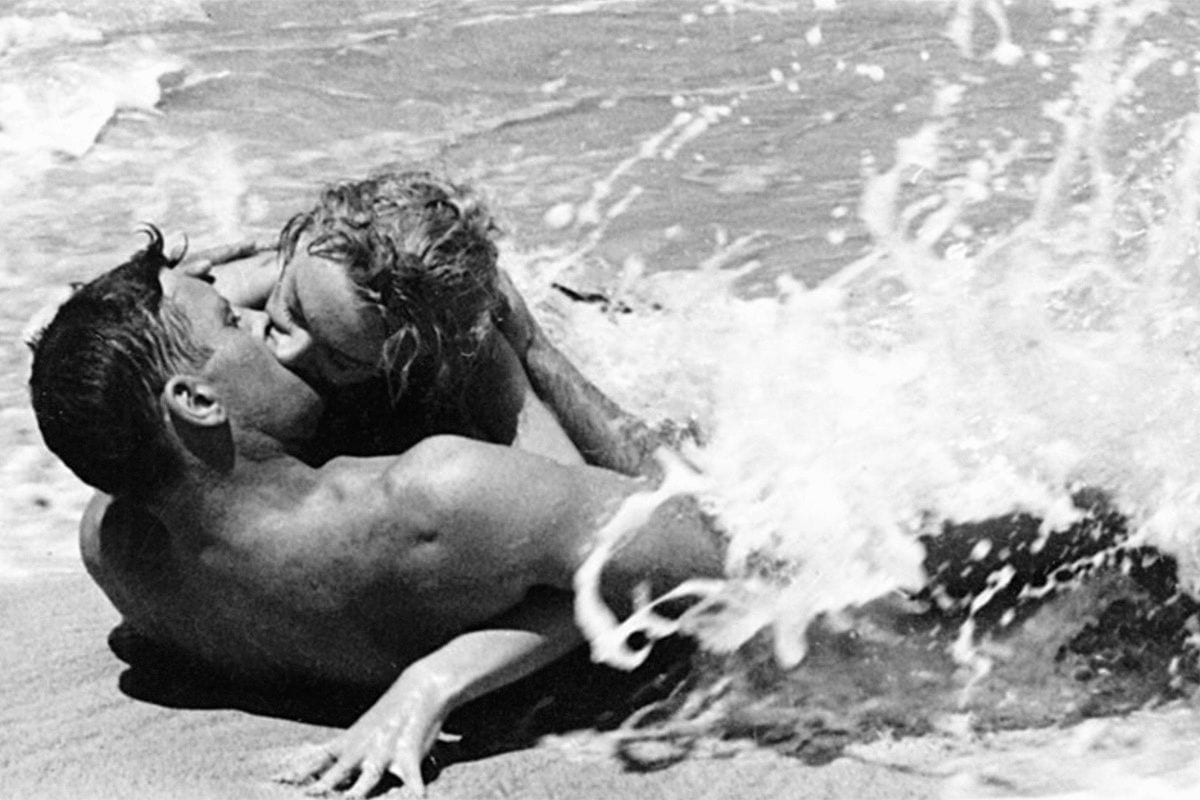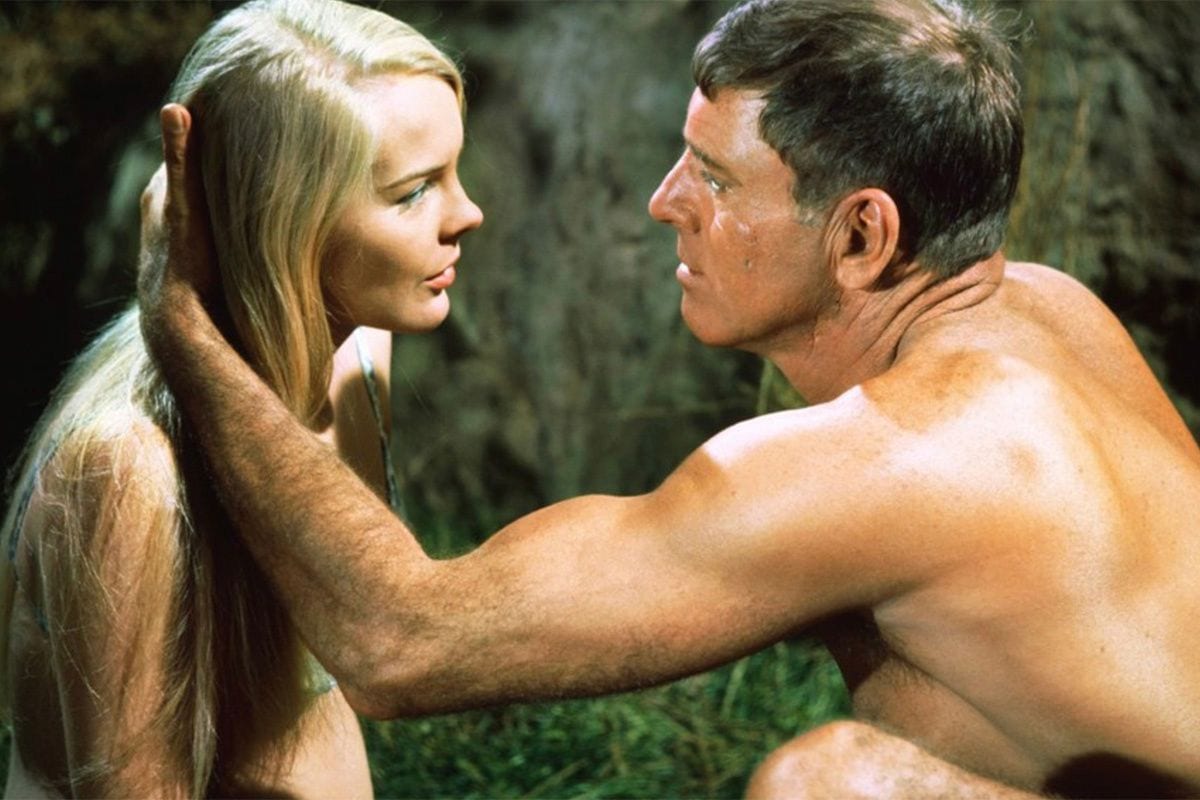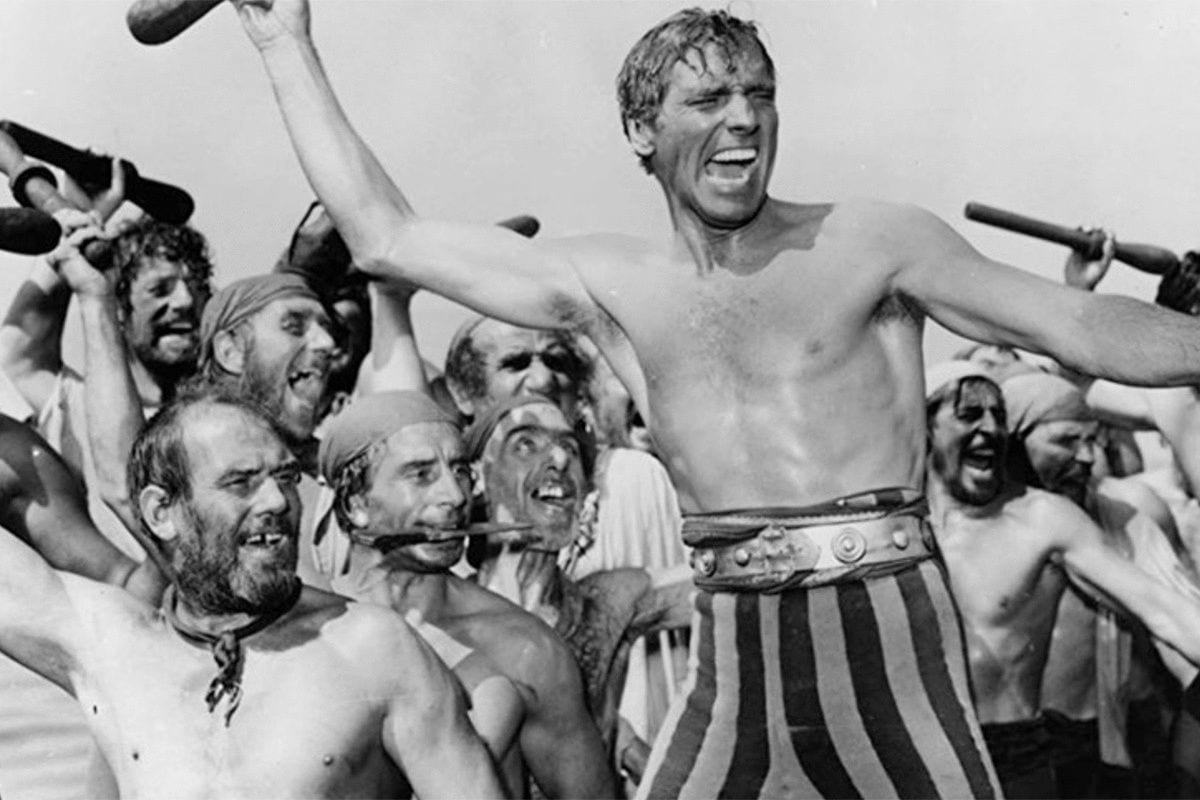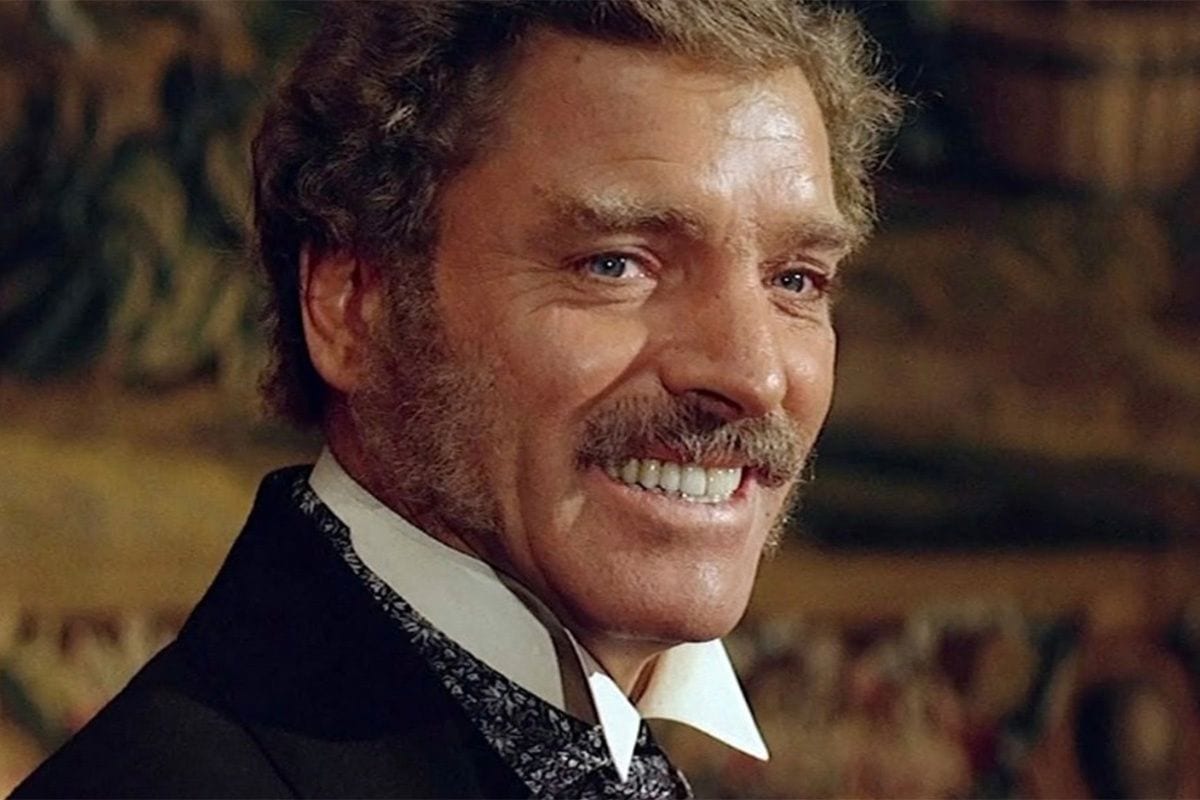The idiom “body of work” refers to the breadth of a person’s professional output. It’s an idiom often employed when discussing the career of Burt Lancaster—largely because, over the course of nearly half a century in film, Lancaster managed to play such a variety of roles both on and off screen. He began his career in film noir (with The Killers in 1946) but quickly branched out to play roles in prestige adaptations of stage plays (such as Arthur Miller’s All My Sons of 1948), swashbucklers (The Flame and the Arrow, 1950), romantic sagas (From Here to Eternity, 1953), westerns (Vera Cruz, 1954), and war films (Run Silent, Run Deep, 1958). He seemed entirely unafraid of tackling new challenges as an actor and playing beyond type; in the latter half of his career he starred in the epic The Leopard (1963) by renowned Italian director Luchino Visconti and the bizarre but engrossing adaptation of John Cheever’s short story, The Swimmer (1968).
He similarly played numerous roles off camera, having established a series of production companies with his agent Harold Hecht that were responsible for many successful films—some starring Lancaster, such as
Vera Cruz, and some not, including Marty (1955) starring Ernest Borgnine, which is one of only two films to win both the Academy Award and the Palme d’Or from the Cannes Film Festival (the other film to do so was 1945’s The Lost Weekend). He even tried his hand at directing with The Kentuckian (1955) and performed many of his own stunts—most notably in the physically demanding Trapeze (1956).
Yet, when thinking of Lancaster as an actor, as a presence in film, “body of work” takes on a more directly corporeal meaning. Lancaster lacks the savoir-faire of a Cary Grant, the preternatural charm of a James Stewart, the otherworldly gravitas of a Gary Cooper or Henry Fonda, the ebullient and overt thespianism of a Kirk Douglas or Laurence Olivier, the intellectualism of a Spencer Tracy or Gregory Peck, the rapscallion appeal of a Clark Gable. What Lancaster seemed to offer was a compelling, magnetic bodily presence.
Of course, there were other physical specimens that populated films in the “Golden Age” of Hollywood, including several of the men just mentioned, but none of them seemed so entirely grounded in their corporeality as did Lancaster. Moreover, none of them seemed to employ his body as the vehicle of his acting in quite the same way as Lancaster. The key to understanding Lancaster’s contribution to film lies in examining the overwhelming and at times discomfiting physicality of his portrayals—including, perhaps especially, in films where that physicality was not the central focus of the script.
Red Swirl by Soorelis (Pixabay License / Pixabay License)
The silent era of film was, of course, replete with an overt physicality that served as the primary vehicle for expression. This is partly what makes some of the acting of that period seem so exaggerated today—most of the meaning had to be conveyed through gesture and movement and the resultant theatricality may appear hyperbolic for taste forged through film of the sound era. With the rise of an increased reliance on spoken dialogue to drive the engine of a film, acting styles became subtler, less expressionistic, and the body was displaced by the voice as the fundamental conveyor of meaning. Perhaps something was lost. The kinetic fervor of a Buster Keaton or the gestural precision of a Greta Garbo suited a medium that relied upon the play of projected light and the swift movement from frame to frame of photography.
But, of course, the body did not disappear from film of the sound era; indeed, it took on the kind of supplemental role that allowed it to act upon the viewer in a more subliminal manner than previously. Scenes of robust physicality (fight scenes, battle scenes, momentary acrobatics) remain but they are the exception and far from the rule in the majority of Golden Age film. For the most part, the body takes a supporting position within the actor’s arsenal. James Stewart is remembered for his vocal inflections (hence the numerous impressionists who can elicit our memories of the actor simply from saying “Mary” in the way Stewart says it in 1946’s It’s a Wonderful Life) but those inflections are reinforced and furthered by his lanky figure, his gently slouching posture, his endearingly hesitant motions.
Similar descriptions could be written for other classic actors. Moreover, Lancaster had his own vocal inflections that are easily mimicked: a kind of stentorian, clipped delivery that often declines toward a baritone growl (or purr, depending on the context of the scene)—allowing him to navigate the space between assertive self-assurance and embittering vulnerability that he so often explores (particularly in his earlier work).
But with Lancaster, those vocal performances are undergirded by a corporeal vitality that suffuses nearly every moment he occupies the screen. This ought not to be surprising. Long before Lancaster (somewhat unwittingly and hesitantly) became involved in acting, he was an athlete, acrobat, and circus performer—working in the latter capacity with his best friend Nick Cravat under the auspices of the Kay Brothers. It was only an injury that derailed his circus career. His rising star in Hollywood was unforeseen and unlikely.
Burt Lancaster and Joan Fontaine in Kiss the Blood Off My Hands (1948) (Film Forum)
After appearing in precisely one Broadway play, A Sound of Hunting (1945)—a gig he reluctantly accepted after being “discovered” in an elevator on his way to visiting a girlfriend and, moreover, a play that had a mere three-week run—he attracted the attention of numerous agents, including Hecht, who made the seemingly presumptuous promise that Lancaster would be producing his own films within five years. (This was a promise Hecht fulfilled with the utmost celerity—it would only be two years into his Hollywood career that Lancaster would produce his first film, Kiss the Blood Off My Hands of 1948.) That moment of discovery and his subsequent meteoric rise was founded upon Lancaster’s physical appearance—he looked the part that the man was attempting to cast.
This physical appeal transferred immediately to his work in film. Lancaster’s first starring role was in an adaptation of a Hemingway short story—The Killers (1946), a film that begins with the assassination of “the Swede” (Lancaster’s character) in Brentwood, New Jersey where he works semi-anonymously as a gas station attendant. The majority of the remainder of the film presents the plot through flashbacks as an insurance investigator (Edmond O’Brien) attempts to get some purchase on who this man was and what he could have done to warrant a professional hit.
There are several moments (mostly revolving around the delivery of dialogue) that demonstrate that Lancaster is still, at this point, a fledgling actor. His cry of “she’s gone” shortly after he is abandoned by the object of his romantic obsession, Kitty Collins (Ava Gardner), crosses the line into awkward melodrama; his occasional lapse into a kind of jovial and exaggerated New York accent (seemingly designed to convey conviviality and camaraderie) strikes the ear as discordant with the character and subtler accent he establishes throughout most of the film. Occasionally, even a certain gesture misfires and comes across as overly forced, just a bit on the wrong side of preciosity.
But by and large, it’s his physicality that cements his characterization. This begins in his first scene in the film, when his coworker runs into the Swede’s rented room to warn him that assassins are on his trail and to encourage him to flee. We see Lancaster’s elongated, tautly muscular form stretched out on a thin bed, his face utterly obscured in darkness. He refuses to run and seems nihilistically resigned to his impending fate, simply averring that he had “done a bad thing—once.” The coworker finally gives up and leaves the room.
The light shifts and we see Lancaster’s face. He turns it blankly toward the door, his visage a sort of empty mask, the eyes vacant in abnegation, the mouth slackened in a kind of weary expectation. He makes no attempt to evade death; he seems to welcome it. As he hears the killers approaching, he props himself up on one elbow and waits—a haunting portrayal, communicated entirely through posture and motionless expression, of a man who is prepared to die, who endures, for a bitter moment, a kind of living death.
A similarly striking scene, but seemingly of an entirely different emotional tenor, occurs further into the film when we see the Swede’s first encounter with Kitty, as she sits at a piano during a party she hosts and the Swede attends. Lancaster plays the moment as a man immediately and completely dumbstruck with an obsessive form of love. We see that first glimpse from behind, from his point of view, just enough of his profile showing that we witness the direction of his glance. And yet, even with the restricted view of his face, Lancaster’s body communicates being transfixed by the unexpected beauty of Kitty.
The Swede approaches her, snubs out a cigarette in an ashtray atop the piano, looks down at his hand as though resisting the urge to make eye contact but then raises his gaze inevitably to meet hers. She walks away and then croons a somewhat contrived torch song. It’s nothing special; it’s not meant to be. But the Swede is entranced and stares a hole into her; he appraises her as a devotee of art appraises a celebrated painting, taken in advance by a presumption of value that might not actually be there. He longs to possess her while somewhere in the back of his mind he realizes that he is irretrievably in her possession, that he is lost to her, that he would die for the opportunity to touch her, to hold her.
In retrospect, we recognize a certain consonance between this look of devotion and the look of resigned expectancy in the scene of the Swede’s murder. In both cases, we witness a man submitting to a fate he can neither resist nor understand. And, of course, we also realize in retrospect that it was the look of devotion that set forth the machinery that eventuated in the look of morbid resignation; it was the flight of his self-possession into an object of desire that did not return that desire that necessitated the stoic willingness to let go of the vestiges of a life and soul that remained to him in his isolation. In both instances, it is the statuesque presence of a body in space that expresses the significance of each moment and their relation to the narrative as a whole.
Burt Lancaster and Deborah Kerr in From Here to Eternity (1953) (Film Forum)
Although presenting a rather more reserved framework than the vehicles of his extravagantly flamboyant physical displays, the widely familiar From Here to Eternity (1953) features further examples of Lancaster’s ability to convey depth of meaning through his body. In this film, Lancaster’s First Sergeant Milton Warden has an affair with the wife of his commanding officer, Karen Holmes, played with remarkable yet restrained pathos by Deborah Kerr. At this stage in her career, Kerr had attained an unparalleled mastery of facial expression through which she telegraphed the subtlest of intimations, creating utterly silent soliloquies touching on the most profound emotional narratives (see, above all, the luau scene in the moments before they are forced to leave to avoid being seen together). She proved a formidable acting partner for many of the leading men paired with her.
Lancaster doesn’t attempt to match her in facial expression, relying instead on an impassive stoicism that communicates determination and insistence—and perhaps relying a bit too much on a smirk intended to denote a preternatural confidence. And yet, the way in which he allows his body to respond to hers—to rise from the waves after she runs, his legs already poised in anticipation of pursuit, his torso bent in the foreknowledge of an embrace, then to collapse inexorably onto her, then to push his mouth forcefully onto hers in the celebrated kiss from the celebrated scene on the beach—imparts something his tone of voice and his face refuse to express, a gentle and longing acquiescence that the smirk and the stoicism belie.
Perhaps the most remarkable physical performance, to my mind at least, by this most marked of physical actors is Lancaster’s turn in The Swimmer (1968). Lancaster (as the main character, Ned Merrill) spends the entirety of the movie in a very tight navy-blue pair of swim trunks—aside from the brief moment when he removes them altogether, exposing his bare behind. In his mid-50s at the time of filming, Lancaster is bronzed and in amazing shape; his physique remains truly impressive but he also reveals subtle signs of aging—the slight elasticity of his flanks as he runs, the almost unnoticeable sagging of flesh about his cheeks, the intimation of crow’s feet about the eyes, the suggestion of thinness in the hair at the very top of his head. These hints of incipient decay and emergent decrepitude are the key to this strange and beguiling film.
The Swimmer tracks Ned’s journey as he attempts to swim across the county by going from pool to pool on his way home from a friend’s house several miles away. With the addition of a new pool at the Graham residence, Ned discerns that there now exists a line of pools connecting his current location to his home. He dubs this the “Lucinda River” in honor of his wife (whom we never see in the film but whom we begin to suspect has left him on the basis of his interactions with friends he encounters along the way). He plans to walk from pool to pool and swim across each until he arrives home.
Janet Landgard and Burt Lancaster in The Swimmer (1968) (Film Forum)
The film (like the Cheever story on which it is based) quickly turns surreal. He runs into a young woman whom he used to employ as a babysitter (Janet Landgard) and convinces her to join him on his journey until he frightens her through an excess of ardor. He stares uncomprehendingly as friends and former associates allude to his having lost his job, his estrangement from his wife, the improper and illicit behavior of his daughters and their disdain for him. He assures everyone that Lucinda and the girls adore him and await him at home. He visits an actress with whom he had an extended extramarital affair (Janice Rule); he fails to understand her bitterness and cannot remember the collapse of their relationship. Even though this is supposed to be a single day’s journey, the seasons seem to shift from midsummer to late autumn beneath his feet. He notices the changes but dismisses them as aberrations (a tree is not simply shedding leaves, it’s blighted).
Throughout the film, Lancaster wears a quixotic expression on his face. No insight of friends and acquaintances into the real nature of his situation (whatever that might be, precisely) is allowed to register. He stares off into a distance, into the unknown, the mystical. He seems comforted by his flight into fantasy but it is disturbing for everyone else, including for the audience watching the film. There is something frightening and sad about watching a man disconnect from reality in order to avoid the quotidian and almost trivial tragedies one faces in a lifetime—the loss of employment, the loss of respect, the loss of love. The story is typically read as an indictment of the upper bourgeoisie, their complacency, their soft ideals, their disconnection from rougher realities, and their suffering manifested of their own designs. But the film reveals that there is more to the Cheever story than this, something more universal (and not merely that feigned universality that the bourgeoisie often touts, that notion that the bourgeois male is the universal by virtue of being the “man in charge”).
Rather, The Swimmer depicts the ravages of an everyday life, the inevitable loss it bears and the utter impossibility, ultimately, of living up to that loss. Because all loss, even the most trivial, is a form of death, a manner of something meaningful going out of existence. Ned sees his life falling away into death and so he projects himself beyond his actual life into a fantasy river (the “Lucinda”) where he is still (literally) immersed in his tony environment, still integrated into the flow of a life that has ejected him, from which he has become alienated whether through his own lack of care or through the mounting indifference of others.
Here is where Lancaster’s body becomes the foundational signifier of the film. His cryptic utterances, born of his willful incomprehension, only bolster a corporeal gambit that Ned plays. In the first half of the film, Ned throws himself ebulliently into the pools. When he arrives at the other end, he pulls himself vigorously out of the water, refusing to use the ladder. His swimming strokes are hardly dexterous (Lancaster, fearful of drowning, had never learned to swim, despite his marked athleticism, until he began preparing for this role) but they make up for their imprecision in exuberance.
Burt Lancaster in The Crimson Pirate (1952) (Film Forum)
There is a desperate vitality to everything Lancaster does in that first half of the film. He wagers himself against the realization of a fate he did not choose by throwing himself corporeally into a situation of his own making. In the second half of the film, that vitality dissipates. He eases himself into the pools and wearily pulls himself out with the aid of the ladder; his energy is sapped, his life is ending. The fantastic journey he erects for himself eventuates in a horrible realization that he cannot fully realize; even at the end, when all is revealed, he is unable to comprehend.
There is a dark lesson to be learned here. If The Swimmer contains a healthy dose of existentialism, it does so in a rather revealing manner. Too often, casual descriptions of existentialism are adolescently heroic. We are thrown (Heidegger’s locution) into a world not of our choosing; our being-toward-death (again, Heidegger) imbues our existence with an urgency, a meaning, and we have to live up to that urgency. We can slip into pre-made, and ultimately meaningless roles (Heidegger, and quite memorably Sartre) but, ultimately, we are condemned to a world of our own making, forged through radically free choice (Sartre and Camus) where at any moment we could choose otherwise, and therefore we are fundamentally responsible for everything we experience.
This heroic narrative (from a situation into which we are thrown toward a life of our own choosing, a choosing informed by our bid for authenticity, for profound individuality) relies upon a view of existence that is overly intellectual, overly cerebral, overly dependent upon a will divorced from the body. In other words, despite Heidegger’s warnings to the contrary, popular approaches to existentialism carry over a Cartesian divide wherein the body is denigrated and disregarded in favor of the mind, which represents what we truly and really are.
But this is simply not so (and despite popular summaries, Heidegger and Sartre both recognized this). Our choices are not radically free from the point of view of the body (even if we might contend that they may be with respect to the spirit or mind). We might be free to think however we choose, but our body imposes a necessary limit on what we can reasonably expect to do in a world of other bodies. The very definition of body involves limit; an item set flush on a table (assuming no actual distance between it and the table) ends where the table begins—touch is the site of separation as much as the site of conjoining.
Burt Lancaster in The Leopard (Il gattopardo) (1963) (Film Forum)
We are bodily presences in the world and insofar as we are immersed in or alienated from the world, that immersion and that alienation involves our bodily relation to other bodies surrounding us. We may be thrown into a world not of our choosing, but in acting upon that world, we throw ourselves into situations that are a rarefied combination of what simply is and what we choose. But a body, any body, disintegrates. It is a wager against time and decay. We throw ourselves against the world, we immerse ourselves within a world, and that takes its toll. The body decays. We are thrown, then learn to throw ourselves, and then our thrownness (our state of being) derives from the manner in which we threw ourselves.
To put it in a less convoluted manner, we are eventually the victims of the decisions we have made. One might say, more optimistically, that we are the beneficiaries of our choices but to view it in this manner is to lose sight of something important. To “suffer” is to undergo something passively, to be affected by something over which we don’t retain full control. And as we age, as we become more and more what we are, we inevitably suffer (passively endure and are affected by) the choices we made previously.
This is an inversion of the normative, heroic existential narrative. Instead of liberating ourselves from the thrownness of our situations through radical and (relatively) unimpeded choice (choice of the mind), we are thrown anew by our past decisions and subject to the consequences of the choices of a past self. We are conditioned by the presumption of being unconditioned when we were younger; those past choices are inscribed into the contours of our corporeality, written into the physical ailments and learned comportments we develop over a lifetime. This reversal of the heroic narrative is essentially tragic. We suffer the fate of our own choosing—but we suffer nonetheless.
This is the lesson Lancaster teaches in The Swimmer. We are, of course, a mind that chooses but we are also a body that suffers. The world is an agglomeration of bodies and we act upon the world by acting upon and within ourselves. Even the finest and most statuesque of bodies (and certainly Lancaster represents that in film as well or better than nearly any other actor) decay and disintegrate. Moreover, even at its point of greatest resolve, the body threatens and promises decay. It is a machine for acting upon the world but there is an ineluctable price to pay.
Our efficacy in and upon the world comes at the cost of our own demise. It isn’t just a matter of life becoming meaningful owing to its unavoidable finitude; it’s a matter of wagering that finitude against the things we wish to accomplish and then suffering the consequences of those attempts to fulfill our wishes. Lancaster teaches us the noble suffering endured by the body; it withstands the blows of the outside world until it can do so no longer. In watching Lancaster, we rejoice at seeing the body stand up to its fate and we commemorate its inevitable decline into the grave.
***
The Film Forum in New York City presents a film festival from Friday, 19 July to Thursday, 15 August, celebrating the many and varied accomplishments of Burt Lancaster on the silver screen. The festival covers the chronological breadth of Lancaster’s career, beginning with his first film The Killers (1946) and including many of his finest performances. The films discussed in this essay are present, of course, and are well worth seeing. The Film Forum will also show several of his landmark performances not discussed in this article. In my opinion, the highlights include The Sweet Smell of Success (1957), Elmer Gantry (1960, the film which won Lancaster a well-deserved Academy Award for Best Actor), The Rose Tattoo (1955), and Local Hero (1983). There are many other wonderful films included on the roster and all are worth seeing in person.

